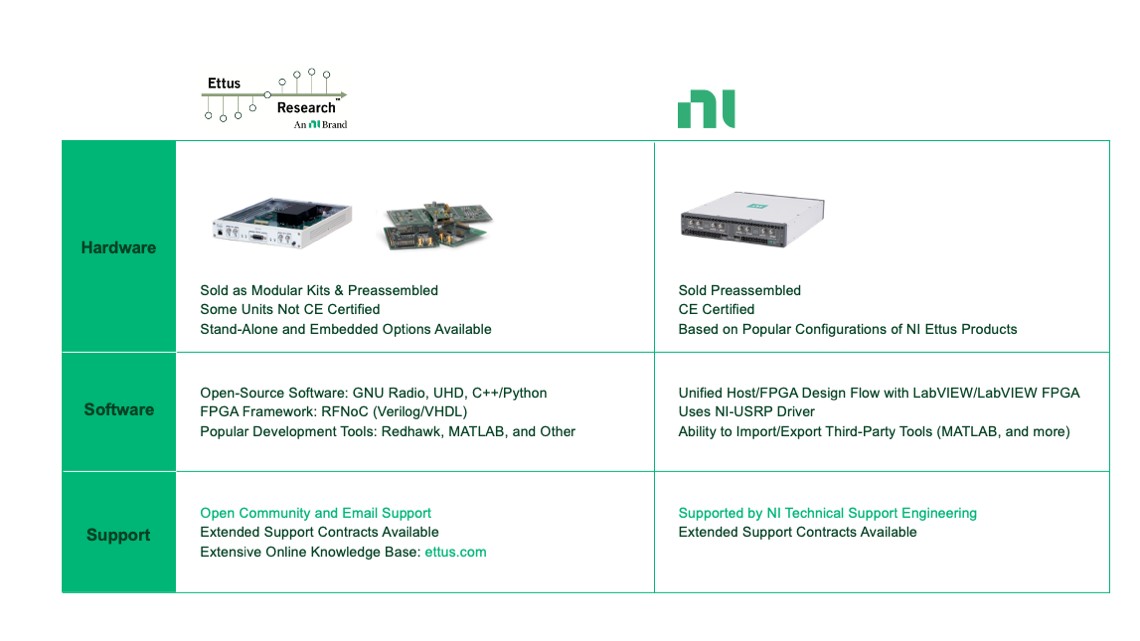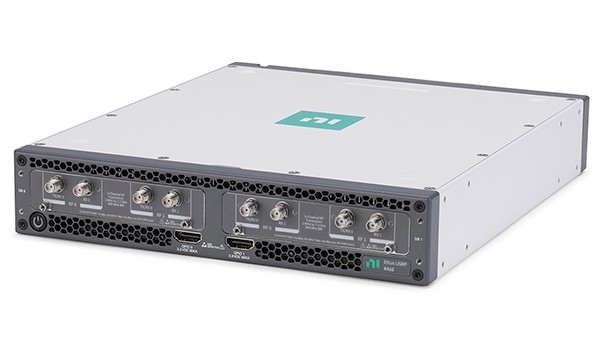What Is the Difference between NI and Ettus Research USRP Devices?
Overview
USRP (Universal Software Radio Peripheral) devices are industry-leading commercial off-the-shelf software defined radios (SDRs). Thousands of engineers around the world use USRP SDRs to rapidly design, prototype, and deploy wireless systems. They are marketed and sold under two different brand names: NI and Ettus Research. Let’s explore the different NI USRP SDRs, such as the USRP-2954, and Ettus Research USRP SDRs, such as the USRP N320.
Contents
- Introduction
- Modular Versus Preassembled Hardware
- Best of Both Worlds: NI and Ettus Research Radio Technology
- Programming in LabVIEW Versus Open-Source Software
- Summary
Introduction
The key differences between NI and Ettus Research USRP SDRs are shown in the following summary chart:

Table 1. Key Differences between Ettus Research SDRs and NI SDRs
Modular Versus Preassembled Hardware
NI and Ettus Research USRP SDRs have two main hardware differences: How the hardware is delivered, and which hardware options are available.
NI USRP SDRs are sold preassembled inside an enclosure, whereas some of the Ettus Research USRP SDRs are sold modularly as kits with the RF daughterboard and motherboard sold separately. For example, the USRP-2945 from NI is the same hardware as an X310 motherboard plus two TwinRX daughterboards. Refer to Table 2 to compare the equivalent USRP models from NI and Ettus Research:
| NI Part Number | Ettus Research Part Number |
|---|---|
| n/a | B200mini/B205mini |
| USRP-2900 | B200 |
| USRP-2901 | B210 |
| USRP-2920 | N210 and WBX |
| USRP-2921 | N210 and XCVR2450 |
| USRP-2922 | N210 and SBX |
| USRP-2930 | N210 and WBX and GPSDO |
| USRP-2932 | N210 and SBX and GPSDO |
| n/a | N310 |
| n/a | N320/N321 |
| USRP-2974 | USRP-2974 |
| USRP-2940 | X310 and WBX |
| USRP-2942 | X310 and SBX |
| USRP-2943 | X310 and CBX |
| USRP-2944 | X310 and UBX |
| USRP-2945 | X310 and TwinRX |
| USRP-2950 | X310 and WBX and GPSDO |
| USRP-2952 | X310 and SBX and GPSDO |
| USRP-2953 | X310 and CBX and GPSDO |
| USRP-2954 | X310 and UBX and GPSDO |
| USRP-2955 | X310 and TwinRX and GPSDO |
| n/a | E310/E312/E313/E320 |
| X410/X440 | X410/X440 |
Table 2. NI versus Ettus Research SDR Model Numbers
One of the benefits of a preassembled USRP SDR is that, prior to shipping, the device undergoes production testing as an assembled unit; but, when it is sold as a kit, each component is tested individually. However, purchasing the motherboard and daughterboard separately offers more flexibility, as some combinations are not available as a single, preassembled device. Some of the latest, most advanced radios sold under the Ettus Research name—such as the USRP N310, USRP N320, USRP N321, Ettus USRP X410, and the Ettus USRP X440—are solely sold as preassembled radios.
Best of Both Worlds: NI and Ettus Research Radio Technology
The NI Ettus USRP X410 is the first in a line of new radios that combines the strength of both NI and Ettus Research. This preassembled radio supports both the popular open-source tool flows such as USRP Hardware Driver (UHD) and GNU Radio as well as LabVIEW. The new SDR is built on the Xilinx Zynq UltraScale+ RF System-on-Chip (RFSoC) and outfitted with high-performance RF transmitter and receiver hardware to deliver NI’s most powerful software defined radio to date. The RFSoC provides a foundation of embedded processor and programmable FPGA, integrated with data converters (analog-to-digital/digital-to-analog converters). The quad-core Arm® processor facilitates stand-alone operation (embedded mode) or host-based mode with an external host machine to run your application.
Figure 1. The NI Ettus USRP X410
Programming in LabVIEW Versus Open-Source Software
While the various USRP models from NI and Ettus Research are based on the same radio hardware, the software support and user preferences vary. NI USRP devices have been predominantly adopted by LabVIEW users with the NI-USRP LabVIEW driver. Ettus Research devices are supported by a common open-source UHD. In addition to these two options, both NI and Ettus Research radios have options to leverage the powerful MathWorks MATLAB®design environment.
USRP LabVIEW Tool Flow Benefits
The abstracted LabVIEW design environment helps accelerate wireless system design and makes FPGA programming accessible to those without HDL design expertise. If you have third-party IP that you want to incorporate, such as MathWorks MATLAB software or VHSIC Hardware Description Language (VHDL) code, you can import it directly from LabVIEW to provide a higher-level starting point and accelerate your application design.
USRP Open-Source Tool Flow Benefits
All Ettus Research USRP SDRs and NI USRP SDRs are supported by the UHD, which is published by NI under open-source licenses. This driver facilitates application development on USRP hardware in C/C++ and offers crossplatform support for multiple industry-standard development environments and frameworks, such as RF Network-on-Chip (RFNoC), GNU Radio, HDL Coder, and MathWorks MATLAB, Simulink®, and Wireless Testbench™ software. As dual-licensed software, the UHD is available under the open-source GNU General Public License version 3 and an alternative, less-restrictive license for volume OEM customers deploying Ettus Research hardware.
While NI USRP SDRs are natively supported by the UHD, you also can provision Ettus Research USRP SDRs with an NI equivalent to use the LabVIEW workflow.
Despite the native UHD support of all NI USRP SDRs, the FPGA image shipped with the unit may not be compatible with the latest version of the driver. Please check the firmware and FPGA image of each device to ensure that the UHD works properly.
Learn more about how you can use this open-source software with Ettus software defined radios to prototype multichannel wireless communication systems.
See Table 3 for a summary of supported software.
| USRP Hardware Driver | NI-USRP | |
|---|---|---|
| OS | Windows Linux Mac OS | Windows NI Linux Real-Time |
| Programming Languages―Host | GNU Radio C/C++ MATLAB/Simulink/Wireless Testbench Python | LabVIEW 2018 and Newer |
| Programming Languages―FPGA | VHDL Verilog RFNoC (Open-Source FPGA Framework) | LabVIEW FPGA |
Table 3. NI and Ettus Research Driver Software Support Comparison
Summary
Although the two brands seem distinct, the USRP SDRs under the Ettus Research brand and the NI brand are more alike than different. In both cases, the hardware is the same, and in most cases, both sets of hardware are supported by both the NI-USRP driver and the UHD.
The registered trademark Linux® is used pursuant to a sublicense from LMI, the exclusive licensee of Linus Torvalds, owner of the mark on a worldwide basis. MATLAB® and Simulink® are registered trademarks of The MathWorks, Inc.
